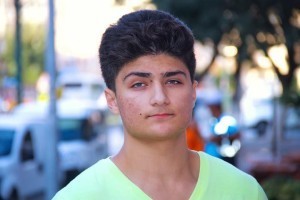Syrian refugee children take over @UNICEF Twitter to tell their powerful stories
2015-09-29

© UNICEF/NYHQ2013-1390/Noorani
A family walk through Zaatari refugee camp in Jordan in 2013.
By Gerrit Beger
The conflict in Syria has entered its fifth year and impacted the lives of millions of children. In Syria, children live in fear of being killed and maimed. Two million children are out of school and 50,000 teachers have fled. Health services have crumbled. Turkey, Lebanon and Jordan are now hosting 4 million Syrian refugees. Recently, headlines have been dominated by reports of thousands of children and their families who are making the extremely dangerous journey to Europe in the hope of a better life.
Each Syrian child has a story to tell – of their journey, of their reality, of their dreams, of their hopes to rebuild Syria. And these stories need to be heard. Building on the success of the youth takeover of our Twitter channel in June for the Day of the African Child, we will be handing over our Twitter account on 30 September to four Syrian children. Aged between 14 and 17 – and now living in Turkey, Jordan and Austria – Youssef, Omaymah, Anhal, and Hanin will each spend an hour sharing their stories and engaging with Twitter users to draw attention to the impact of the conflict in Syria on the lives of millions of other children like them.
The takeover will happen the same day as an important discussion at the United Nations on refugee and migration flows – helping to ing their voices to those with the power to make lasting change.
Here’s how you can get involved
Starting at 8 am EST/ 12 pm GMT, every hour on the hour until 12 pm EST/ 6 pm GMT, each participant will be given the reins to the global UNICEF Twitter account. You can read their powerful personal narratives by following tweets on the UNICEF account or by following the hashtags #youthtakeover and #refugeecrisis (You don’t have to have a Twitter account to do this!)
We invite you to retweet their words to spread their messages even wider and to raise awareness about the situation of child refugees. You will also be able to ask each child questions about their journey and the challenges they face.
At the end of the day, we’ll capture the entire experience on Storify and make it available for all who won’t be able to make it on the day.
Who will be taking over @UNICEF on September 30?
 |
Youssef (17), living in Turkey Youssef left Syria two years ago with his mother and two others. To get to Turkey from Aleppo they travelled by bus, fearing attacks along the way. Once in Turkey, Youssef, together with his younger other and cousin began to look for work. Youssef worked at a construction company for 11 hours a day, but is now enrolled in school. School is very important to him, but after his classes finish he has to head off to work and is there until 10 pm. When he lived in Syria he dreamed of building a technology company – but now his dream is to rebuild his home country. He believes that Syrian children and youth want and need some work and study opportunities. |
 |
Omaymah (14), living in Za’atari camp, Jordan
Omaymah arrived in the camp in December 2012 from a village called Mahajah in Daraa. Their village was being bombed almost every day and she fled Syria with her parents and four others. On their way to Jordan, their bus was attacked. When they eventually arrived in Za’atari, Omaymah initially thought they wouldn’t be staying there for very long. She had cousins who were already in the camp and it was easy for her to make new friends. After one day she registered at school. Her favourite subject is Science and she is now in 8th grade at a UNICEF-supported school. She believes that education is the future |
of a girl and is firmly against early marriage. In her free time she loves painting and visiting her friends, but free time is hard to come by as she has to support her family with tasks like cooking.
|
Anhal (16), living in Za’atari camp, Jordan
Anhal arrived in Za’atari Camp in November 2012 from Daraa, Syria, with his mother and two sisters. He has 5 others and 5 sisters: one sister remained in Syria with her family and one other lives with his family in UAE. To get to Jordan they left in a rented van which took them as far as 5 km from the border – from there they had to walk. When he first arrived in the camp he was both happy and sad: happy that they were safe and sad because he had left his home. He lost a year of schooling at the camp but his father ensured that he enrolled in a school andAnhal is now in grade 11. He has consistently been one of the top |
 |
|
Hanin (16), living in Austria
Hanin was 13 when she left Syria with her mother and her older sister after a bomb destroyed their house. Her others had already left the country. They travelled by bus to Istanbul where they stayed for two years. On their journey to Europe, Hanin was separated from her family. Alone, supported by strangers, she travelled to Hungary, and eventually crossed into Austria. She lived there alone for a year, but was reunited with her mother a few months ago. Like so many others, she misses Syria deeply, and hopes to be either a dentist or a photographer. |
 |
| Donate NOW, help children in crisis around the world! |









